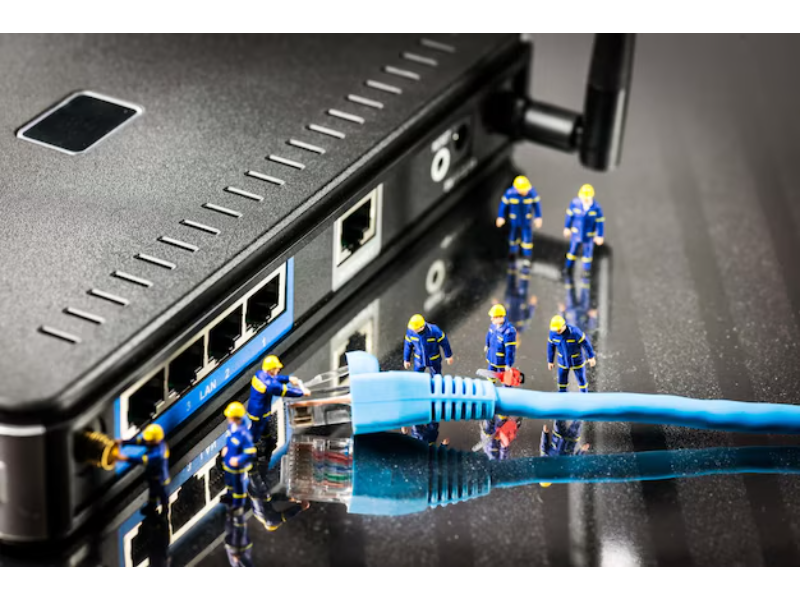- The internet infrastructure, comprising hardware, software, and protocols, underpins global connectivity and the digital economy.
- Emerging technologies like 5G, satellite internet, and green data centers are reshaping the future of internet infrastructure, addressing sustainability and accessibility challenges.
The internet has become an indispensable part of daily life, supporting global commerce, communication, and innovation. At the heart of this digital ecosystem lies internet infrastructure — a robust system of hardware, software, and protocols working seamlessly together to enable connectivity worldwide. Despite being largely invisible to the average user, it is this infrastructure that ensures the smooth operation of everything from social media platforms to critical healthcare systems. In this article, we will explore the components of internet infrastructure, its challenges, and its future, supported by expert insights.
Also read: Who maintains the internet’s infrastructure?
Also read: Interview with DE-CIX: Impact on global internet infrastructure
Understanding internet infrastructure

Internet infrastructure refers to the technological framework that supports the internet. It encompasses physical hardware such as servers, cables, and routers, as well as software and protocols like DNS and IP that manage data flow. Together, these components create a system capable of connecting billions of devices globally, enabling seamless communication, commerce, and innovation.
Vint Cerf, often called the “Father of the Internet,” once remarked, “The internet’s infrastructure is the lifeblood of our global economy. Without it, innovation and progress would come to a halt.” This statement underscores the profound impact of internet infrastructure on modern life, driving industries ranging from e-commerce to healthcare. Similarly, Sir Tim Berners-Lee, inventor of the World Wide Web, highlights its societal role: “The internet is a public resource that depends on robust infrastructure to ensure equal access and opportunity for all.”
Without these critical systems in place, everyday activities like streaming videos, conducting online transactions, or even accessing cloud-based applications would be impossible. Sundar Pichai, CEO of Google, emphasizes its transformative potential: “A strong internet infrastructure enables technological innovation and economic growth, allowing us to harness the power of AI and cloud computing.” These insights illustrate that internet infrastructure is not just a technical foundation but a catalyst for global progress and innovation.
A strong internet infrastructure enables technological innovation and economic growth, allowing us to harness the power of AI and cloud computing.
Sundar Pichai, CEO of Google
Also read: Who builds the internet’s infrastructure?
Also read: What is the primary infrastructure that creates the internet?
Key components of internet infrastructure

To understand the internet’s functionality, let’s break down its critical components into physical and logical layers.
1. Physical infrastructure
Physical infrastructure forms the backbone of internet operations, enabling the transmission of data across vast distances.
- Undersea and fiber-optic cables
These high-capacity cables transmit data using light, allowing for almost instantaneous communication between continents. According to TeleGeography, over 400 undersea cables span the globe, supporting 99% of international data traffic. For instance, the Marea cable connects Virginia Beach, U.S., to Spain, handling up to 200 terabits of data per second. - Data centers
Housing millions of servers, data centers process, store, and transmit massive volumes of data. John Dinsdale, Chief Analyst at Synergy Research Group, highlights their importance: “Without modern data centers, today’s cloud computing, streaming services, and real-time applications would be impossible.” - Wireless networks
Cellular towers, satellites, and Wi-Fi access points extend the reach of the internet, especially in rural or underserved areas. Technologies like 5G promise to bring faster speeds and lower latency to these wireless networks.
Without modern data centers, today’s cloud computing, streaming services, and real-time applications would be impossible.
John Dinsdale, Chief Analyst at Synergy Research Group
2. Logical infrastructure
Logical infrastructure encompasses the rules and software protocols that govern data exchange.
- IP addresses and DNS
The Domain Name System (DNS) acts as the internet’s directory, translating domain names into machine-readable IP addresses. For example, typing “google.com” into a browser is translated into its corresponding IP address, enabling access. - Data routing and protocols
Protocols like Transmission Control Protocol/Internet Protocol (TCP/IP) ensure data packets are delivered accurately, while Border Gateway Protocol (BGP) manages how packets travel between networks.
3. Internet service providers (ISPs)
ISPs deliver internet services to end-users, maintaining regional infrastructure and enabling last-mile connectivity. Major players like AT&T, Comcast, and China Telecom are critical in connecting homes and businesses.
Also read: How does internet infrastructure work?
Also read: Can Africa’s internet infrastructure cope with the future?
Why internet infrastructure is essential

The significance of internet infrastructure lies in its ability to sustain the global digital economy, foster innovation, and address critical challenges such as connectivity gaps and cybersecurity threats.
- Facilitating economic growth
According to a study by the World Bank, a 10% increase in broadband penetration can lead to a 1.38% increase in GDP growth in developing countries. Platforms like Amazon and Alibaba rely on robust internet infrastructure to support their global operations. Nobel Laureate in Economics, Paul Romer, stated, “Access to reliable internet infrastructure creates opportunities for innovation, enhances productivity, and helps economies thrive in the digital age.” - Bridging the digital divide
Initiatives like Google’s Project Taara, which uses light beams to provide connectivity in remote areas, demonstrate how infrastructure can connect underserved regions. Vint Cerf has emphasized, “Universal internet access is not a luxury; it is essential for education, commerce, and civic engagement in the modern era.” Such efforts aim to close the gap between urban and rural areas, promoting equitable growth. - Driving technological innovation
Emerging technologies like AI, blockchain, and autonomous vehicles rely on reliable and scalable infrastructure to process vast amounts of data in real time. Sundar Pichai, CEO of Google, noted, “The future of innovation is intrinsically tied to the strength and adaptability of our internet infrastructure.” This interdependence underscores the need for continuous investment in advanced infrastructure to keep pace with technological progress. - Global security
A secure internet infrastructure is vital for national defense, protecting critical systems from cyberattacks. US Cybersecurity and Infrastructure Security Agency (CISA) director Jen Easterly has stated, “The strength of our internet infrastructure is directly tied to our national security and economic resilience.” Her remarks highlight the growing risks of cyber threats and the need for international collaboration to safeguard critical infrastructure.
By enabling economic growth, bridging the digital divide, driving innovation, and ensuring security, internet infrastructure proves to be a cornerstone of modern society.
The strength of our internet infrastructure is directly tied to our national security and economic resilience.
Jen Easterly, US Cybersecurity and Infrastructure Security Agency (CISA) director
Pop quiz
What is the primary function of the Domain Name System (DNS) in internet infrastructure?
A. To store and process user data in data centers.
B. To convert domain names into machine-readable IP addresses.
C. To route data packets across undersea cables.
D. To ensure secure access to wireless networks.
(The correct answer is at the bottom of the article)
Challenges in building and maintaining internet infrastructure

Despite its critical importance, developing and maintaining internet infrastructure faces significant hurdles.
1. High costs and geographical barriers
Building infrastructure in remote or underdeveloped areas often requires significant investment. For instance, undersea cable installations cost hundreds of millions of dollars and can take years to complete. Projects in rural regions, where population density is low, often yield low returns on investment.
2. Cybersecurity threats
With cyberattacks on the rise, safeguarding infrastructure has become a priority. Attacks targeting routers, DNS servers, or undersea cables can have widespread impacts. Cybersecurity expert Bruce Schneier emphasizes, “Internet infrastructure is a prime target for attackers because disrupting it can cripple entire economies.”
3. Environmental impact
Data centers consume vast amounts of energy. According to the International Energy Agency (IEA), they account for 1% of global electricity demand. Transitioning to sustainable solutions like renewable energy-powered facilities is a growing focus.
4. Regulatory challenges
Navigating complex regulations across countries can delay infrastructure projects. For instance, debates over net neutrality policies in the U.S. highlight the tension between regulation and innovation.
Internet infrastructure is a prime target for attackers because disrupting it can cripple entire economies.
Bruce Schneier, a cybersecurity expert
Emerging trends in internet infrastructure

As the internet evolves, infrastructure is adapting to meet new demands.
1. 5G and 6G networks
The rollout of 5G networks is transforming connectivity, enabling ultra-fast speeds and minimal latency. Looking ahead, 6G networks promise to integrate communication with AI-driven applications.
2. Green data centers
Companies like Google and Microsoft are pioneering the use of renewable energy in their data centers, aiming for net-zero emissions. Google’s Climate Insights Team reports that their facilities are now twice as energy-efficient as the industry average.
3. Satellite internet
Projects like SpaceX’s Starlink and Amazon’s Project Kuiper aim to provide high-speed internet in remote areas using satellite constellations. Starlink, for example, already serves users in over 50 countries.
4. Edge computing
By processing data closer to the source, edge computing reduces latency, which is critical for real-time applications like autonomous vehicles and augmented reality. Gartner estimates that by 2025, 75% of enterprise-generated data will be processed at the edge.
The future of internet infrastructure

The future of internet infrastructure will be shaped by advancements in technology and global collaboration. Key areas of focus include:
- Global internet governance
The need for a unified framework to manage cross-border data flows and cyber threats is growing. - Sustainability goals
As internet traffic grows, eco-friendly infrastructure will become imperative. Industry-wide initiatives, such as the Climate Neutral Data Center Pact, are setting benchmarks for sustainability. - AI integration
AI will enhance network optimization, predictive maintenance, and cybersecurity, making the internet more efficient and secure.
Internet infrastructure is the foundation of the digital world, enabling everything from everyday communication to transformative innovations. While challenges such as cybersecurity risks and environmental concerns persist, advancements in 5G, green technologies, and satellite internet offer promising solutions. As Vint Cerf aptly noted, “The future of the internet depends on our ability to build a strong, secure, and sustainable infrastructure.” By prioritizing investment and collaboration, we can ensure the internet continues to drive global progress in the years to come.
FAQ
Internet infrastructure refers to the physical hardware, software, and protocols that enable global internet connectivity. It includes servers, data centers, undersea cables, routers, and systems like DNS that manage data flow.
It supports global communication, powers the digital economy, and enables essential services like e-commerce, remote work, and streaming. Without robust infrastructure, modern technologies and economic growth would stagnate.
By investing in technologies like satellite internet, fiber optics, and wireless broadband, infrastructure projects aim to connect underserved areas, improving access to education, healthcare, and economic opportunities.
Data centers store and process vast amounts of data, serving as the backbone of cloud services, websites, and applications. They ensure that digital content is available, secure, and accessible at all times.
Key trends include the deployment of 5G networks, the use of green energy in data centers, advancements in undersea cable technology, and the rise of edge computing to reduce latency for real-time applications.
Quiz answer
B. To convert domain names into machine-readable IP addresses.

